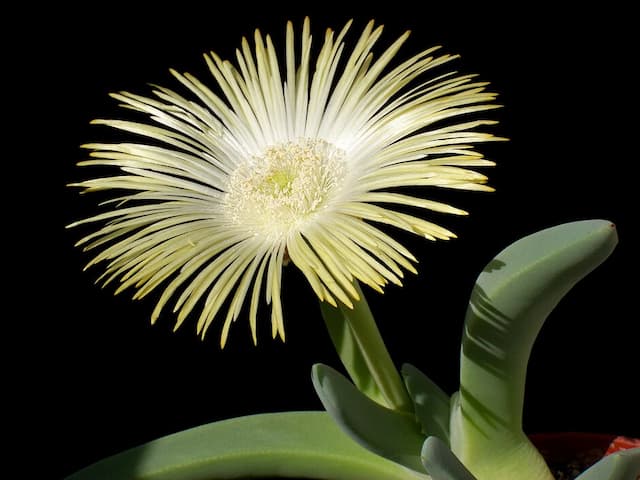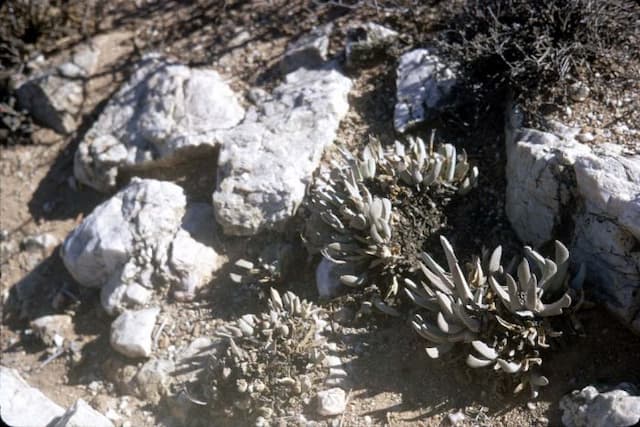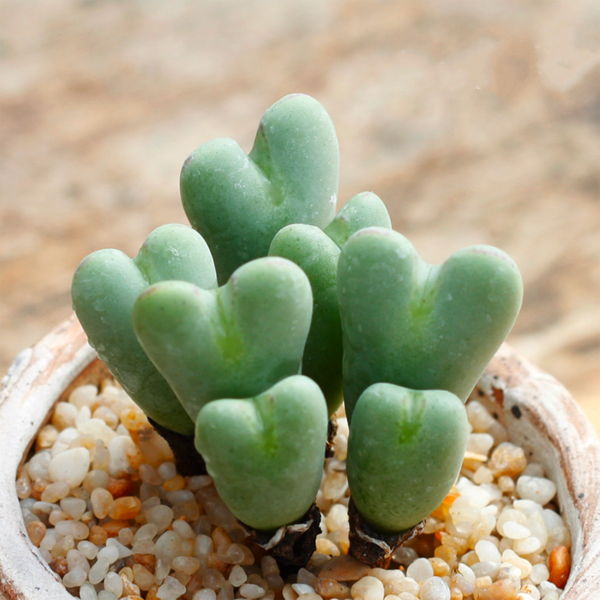Concrete Leaf Titanopsis calcarea

ABOUT
The plant commonly referred to as concrete leaf is a unique and fascinating succulent. Its leaves are its most striking feature, being chunky and knobbly, almost resembling the pebbles or gravel amongst which it often grows. The leaves are a mix of green, gray, and brown shades with a rough, warty surface giving them a look of weathered stones, a perfect example of camouflage in the plant world. This adaptation allows it to blend seamlessly into its rocky habitats to avoid detection by foragers. During the cooler months, the concrete leaf may exhibit more intense coloration; with the right light conditions, the tips of the leaves can take on a reddish or purplish hue. The leaves grow in a rosette pattern, hugging the ground in a low, clumping manner. Come blooming season, the plant produces daisy-like flowers that offer a contrast to the stony appearance of the leaves. The flowers are usually yellow or occasionally with a hint of orange, rising just above the foliage on short stems. Despite its rugged appearance, this plant can surprise onlookers with the delicate beauty of its blooms.
About this plant
 Names
NamesFamily
Aizoaceae
Synonyms
Concrete Leaf, Jewel Weed, Carpet Leaf, Living Stone, Concrete Leaf Plant
Common names
Mesembryanthemum calcareum, Titanopsis schwantesii, Titanopsis hugo-schlechteri, Titanopsis fulleri, Titanopsis calcarea var. schweickerdtii.
 Toxicity
ToxicityTo humans
Concrete Leaf is generally not considered toxic to humans. There are no widespread reports or studies indicating that ingestion of Titanopsis calcarea, commonly known as Concrete Leaf, causes poisoning or toxic symptoms in humans. Therefore, accidental ingestion is unlikely to result in any significant negative consequences. However, as with any non-food plant, it is advisable not to consume it, and care should be taken, particularly with children and individuals with sensitive systems.
To pets
Concrete Leaf is not known to be toxic to pets. It does not appear on toxic plant lists for animals commonly kept as pets such as dogs and cats, and there is no known history of the plant causing poisoning in pets. Ingestion of Titanopsis calcarea, commonly called Concrete Leaf, should not result in any significant toxicity or dangerous symptoms. However, it's always best to prevent pets from eating plants as a precaution to avoid any potential stomach upset or other digestive issues.
 Characteristics
CharacteristicsLife cycle
Perennials
Foliage type
Evergreen
Color of leaves
Variegated
Flower color
Yellow
Height
0.2 feet (6 cm)
Spread
0.2 feet (6 cm)
Plant type
Succulent
Hardiness zones
10
Native area
South Africa
Benefits
 General Benefits
General Benefits- Low Maintenance: Titanopsis calcarea, commonly known as Concrete Leaf, is a succulent that requires minimal care, making it ideal for busy or forgetful gardeners.
- Drought Tolerant: As a succulent, Concrete Leaf has adapted to survive with very little water, making it suitable for arid climates and water-conservation gardens.
- Unique Aesthetic: The plant has a distinctive, rough texture and appearance that resembles concrete, adding visual interest to rock gardens and succulent collections.
- Cold Hardy: Concrete Leaf is relatively cold-tolerant compared to other succulents, able to withstand frost and low temperatures better than many of its counterparts.
- Easy Propagation: It can be easily propagated from leaves or offsets, allowing gardeners to expand their collection without purchasing new plants.
- Long Lifespan: With proper care, Titanopsis calcarea can live for many years, providing long-lasting enjoyment in the garden or home.
- Small Size: This plant remains small, making it an ideal choice for container gardening, terrariums, and small spaces.
- Pest Resistant: Concrete Leaf tends to be resistant to common garden pests, reducing the need for chemical interventions.
- Seasonal Interest: It produces yellow-to-orange flowers in autumn or early winter, providing seasonal interest when many other plants are dormant.
- Soil Adaptability: Titanopsis calcarea can thrive in poor, well-draining soils, where many other plants may struggle.
 Medical Properties
Medical PropertiesThis plant is not used for medical purposes.
 Air-purifying Qualities
Air-purifying QualitiesThis plant is not specifically known for air purifying qualities.
 Other Uses
Other Uses- Titanopsis calcarea, commonly known as Concrete Leaf, can be employed in rock gardens due to its rugged appearance that complements the aesthetic of natural stone and gravel.
- Concrete Leaf can serve as an educational tool in botany classes to illustrate survival adaptations of plants in arid environments.
- In landscaping, Concrete Leaf plants are utilized to fill crevices in walls or pathways, providing a unique texture and color contrast.
- This plant can be used in miniature gardening and fairy gardens, offering a realistic scale representation of larger rocky landscapes.
- Concrete Leaf's intriguing form and coloration make it a popular choice for artistic still-life photography, showcasing the beauty of succulents.
- As a living mulch, Concrete Leaf can be grown to cover soil, helping reduce water evaporation in arid climate garden beds.
- The compact nature of Concrete Leaf allows it to be used in vertical gardening, adding greenery to urban spaces with limited ground area.
- Concrete Leaf can be cultivated in terrariums as part of a mixed display with other small desert plants, creating a micro desert ecosystem.
- During times of water restrictions, Concrete Leaf can be used as a water-wise alternative in decorative plantings where traditional, water-intensive plants would fail.
- For culinary presentation, although not edible, the striking appearance of Concrete Leaf can be used as a natural garnish for plating, especially in avant-garde restaurants looking to add an organic touch.
Interesting Facts
 Feng Shui
Feng ShuiConcrete leaf plant is not used in Feng Shui practice.
 Zodiac Sign Compitability
Zodiac Sign CompitabilityConcrete leaf plant is not used in astrology practice.
 Plant Symbolism
Plant Symbolism- Resilience: The Concrete Leaf plant, Titanopsis calcarea, is known for its tough and rugged leaves that mimic the appearance of stones or concrete, symbolizing the ability to endure and thrive in harsh conditions.
- Adaptability: As a succulent that thrives in challenging environments, the Concrete Leaf plant represents the capacity to adapt to changing circumstances and to make the most out of difficult situations.
- Camouflage: With leaves that blend into rocky surroundings, this plant symbolizes the concept of camouflage and protection. It reflects the idea of blending in to safeguard oneself from adversity.
- Survival: Titanopsis calcarea's ability to survive with minimal water in desert-like conditions speaks to the theme of survival and the tenacity of life.
- Uniqueness: The unusual texture and form of the Concrete Leaf plant's foliage celebrate uniqueness and the beauty found in embracing one's individuality.
 Water
WaterThe Concrete Leaf plant, commonly called Titanopsis calcarea, should be watered sparingly, as it is a succulent and prone to root rot. During the active growth period in fall and winter, water every two to three weeks, allowing the soil to dry out completely between waterings. In its dormant summer period, reduce watering to once a month. When you do water, provide enough to soak the soil, using about 8-16 ounces, depending on the size of the pot. Overwatering is a common mistake and can cause the plant to rot, so err on the side of underwatering.
 Light
LightFor Concrete Leaf plant, full sun to partial shade is optimal. They thrive in bright light conditions, so a south or west-facing window is an ideal location. Direct sunlight is beneficial, but in hotter climates, some afternoon shade may be necessary to prevent scorching the leaves.
 Temperature
TemperatureThe Concrete Leaf plant is best kept at a temperature range between 50°F and 75°F. It can handle short periods of colder temperatures down to about 32°F, but should not be exposed to frost. During the summer, it can withstand higher temperatures but should be shaded from the most intense afternoon sun.
 Pruning
PruningPruning is generally not required for the Concrete Leaf plant. However, you may remove dead or dying leaves as needed to encourage healthy growth and improve air circulation. The best time to prune is in the plant's active growing period, fall and winter.
 Cleaning
CleaningAs needed
 Soil
SoilThe Concrete Leaf Plant (Titanopsis calcarea) requires a well-draining soil mix with a slightly acidic to neutral pH of around 6.0 to 7.5. A mixture comprised of one part potting soil, one part coarse sand, and one part perlite or pumice is ideal for providing the necessary drainage and aeration.
 Repotting
RepottingThe Concrete Leaf Plant should be repotted once every two to three years or when it outgrows its pot. This succulent does not have a large root system, so frequent repotting is not necessary.
 Humidity & Misting
Humidity & MistingThe Concrete Leaf Plant thrives in dry conditions and does not require high humidity levels. Average room humidity is generally adequate for this succulent species.
 Suitable locations
Suitable locationsIndoor
Place in a sunny spot, water sparingly.
Outdoor
Needs full sun, well-draining soil, minimal water.
Hardiness zone
10-11 USDA
 Life cycle
Life cycleTitanopsis calcarea, commonly known as Concrete Leaf or Jewel Weed, begins its life cycle as a seed released from a fruit capsule after the parent plant flowers. The seed germinates, typically during a wet period, and starts as a tiny rosette, absorbing water and nutrients from the soil. It grows slowly, developing thick, fleshy leaves with a warty appearance adapted to its arid environment for water storage and reduced evaporation. During the vegetative growth stage, Concrete Leaf remains small and may produce offsets, contributing to its clumping growth habit. Flowering occurs in autumn to early winter, presenting daisy-like flowers with bright colors that attract pollinators for sexual reproduction. After pollination and seed formation, the cycle begins anew when conditions are favorable for germination.
 Propogation
PropogationPropogation time
Spring-Early summer
Propogation: The most common method for propagating Titanopsis calcarea, also known as Concrete Leaf or Jewel Plant, is through seed sowing. This is often done in late winter or early spring to synchronize with the plant's natural growth cycle. Seeds are thinly distributed over a well-draining cactus mix and lightly covered with a thin layer of sand or fine grit. The surface should be kept moist but not waterlogged by gently misting it. A temperature between 70 and 77 degrees Fahrenheit (21 to 25 degrees Celsius) is ideal for germination. It’s important to provide plenty of light but avoid direct sun which can scorch the young seedlings. Germination may take from two weeks to a month and as the seedlings develop, they should be gradually acclimatized to drier conditions characteristic of adult Titanopsis calcarea plants.

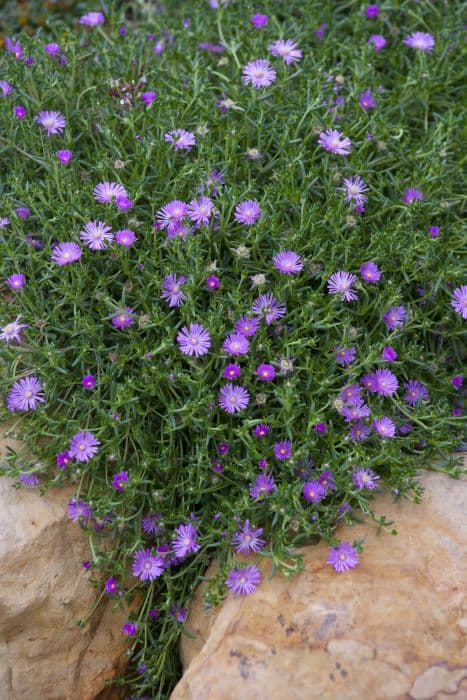
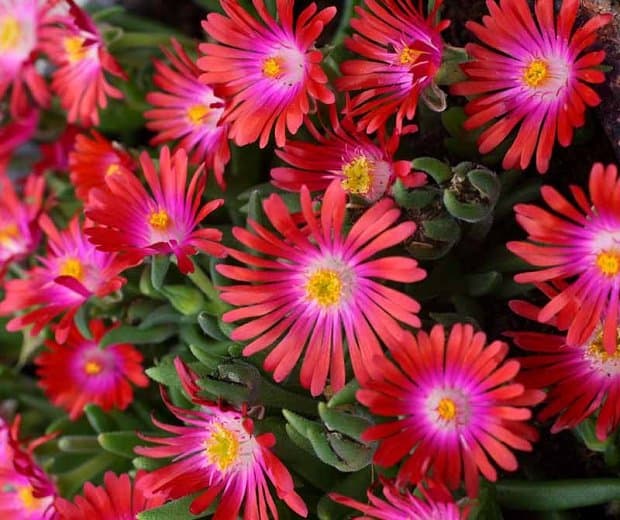
![Ice plant [Fire Spinner]](/_next/image?url=https%3A%2F%2Fplants-admin.emdemapps.com%2Fimages%2Fplants%2F%2Fimages%2F604b54d98722a.png&w=640&q=75)


